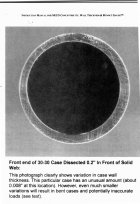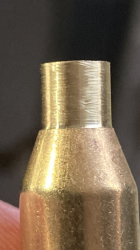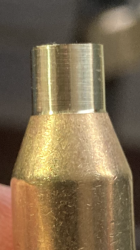I'll just try a expander I have and see how it goes. Have you done chamber casting to know that factory neck clearances are generous?
There is an assumption by the participants who are offering you advise and that is "If you ask a question then you are trying to learn or gain insight." However, if you immediately respond staccato style with challenging/contrary opinions or sharp tone then people start thinking that you are either Trolling or obtuse. I will try to help.
I am not an F-class shooter. I am more of a practical shooter who does pursue accuracy/precision. I neck turn because I am forming brass cases. When necking down a case, the neck's wall thickness is increases as you force a larger diameter neck into a smaller diameter neck (same volume of brass now reformed into a smaller diameter neck). I am neck turning so that the newly formed case will fit into the rifle chamber and and also fit a bullet inside the case. This isn't your issue with a factory rifle.
Factory barrels tend to have loose chambers as a result of manufacturer's using reamers that will cut a chamber that can fit any factory ammo into it and function reliably, which translates into more generous dimensions. Factory rifles are geared toward 1moa construction. Specs for a deer rifle are significantly different then for precision shooting. This is not to say that you might get lucky and have a tighter chamber or a sub 1MOA rifle with a factory setup, but it is less likely.
Assuming that the chamber is loose (oversized compared to a custom built rifle/premium barrel) then neck turning (reducing the neck diameter) will enlarge the gap between the case neck dimension and the chamber's neck dimension. Regardless of the thickness of the neck's case walls, the neck will expand during firing to fit the rifle's chamber. This may or may not affect your accuracy, but it does shorten the brass life because you are now shrinking and expanding the case neck a greater distance then if neck's brass was not turned (thinned). Even without neck turning, different brand brass cases (different headstamps) are known to have different case thicknesses and correspondingly may fit a specific chamber more tightly or loosely.
For a factory rifle, neck turning cases is much further down the list of steps to improving accuracy. You will gain more from replacing factory trigger, upgrading stock (bedding the action and if crappy tupperware stock getting a new rigid stock), quality bullets that match to your barrel's twist rate, quality brass for reloading (buy a box or two of Lapua) or at least make certain brass is same brand (mixed range brass is to inconsistent for to be reliably for precision). Lastly, spend some time developing a load, which may require trying several different bullets and powder combinations. Even when I know the bullet, powder, and COAL, I will still go through a box of bullets (50-100 rounds) dialing in my powder charge to find most accurate load. If you are already doing this then you have covered the basics.
The easiest way to avoid the doughnut is to Full Length Resize your brass. If you want to go an extra step you can remove the expander button from the Resizing die and in a second step use an expander mandrel to create a uniform Neck ID to improve neck tension. You may or may not notice any difference in a factory chambered barrel.
As a kid I spent endless hours trying to max out the potential accuracy of factory rifles. With reloading I could always improve a rifles performance, but there was a limit to how much. Some guys like chasing a problem and the pleasure is this activity, and not the outcome. I learned from watching my dad that there was a limit to how much effort I was willing to throw down a hole blindly without knowing if it would be wasted. I have rifles that I decided from the onset that 1moa is all I wanted or needed from it and the only change was to improve the trigger if needed. I have other rifles that I want one hole accuracy and that is a totally different pony. If it were me then before I would consider neck turning, I would start with rebarreling the rifle with a premium quality barrel (Bartlein, Kreiger, Leija, etc) done by a competent gunsmith.













